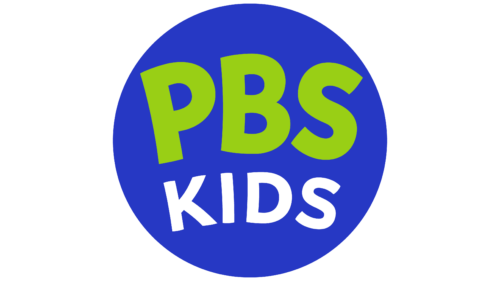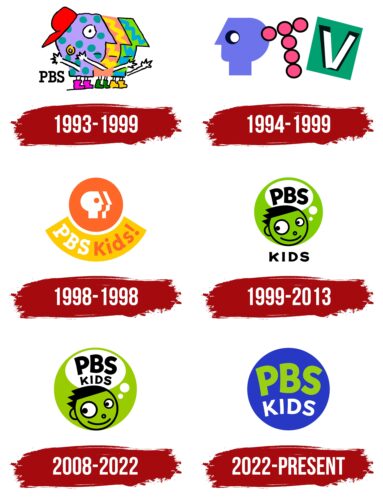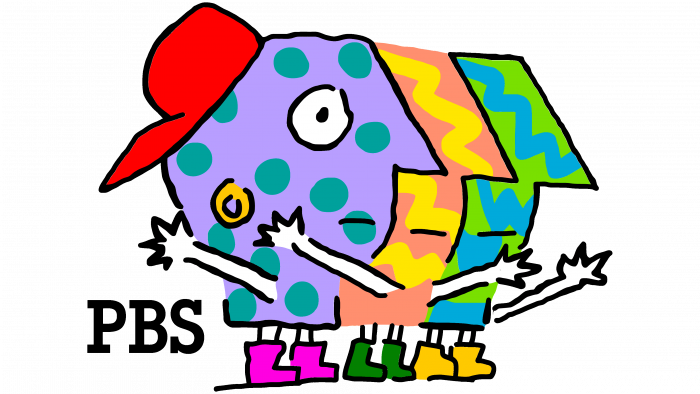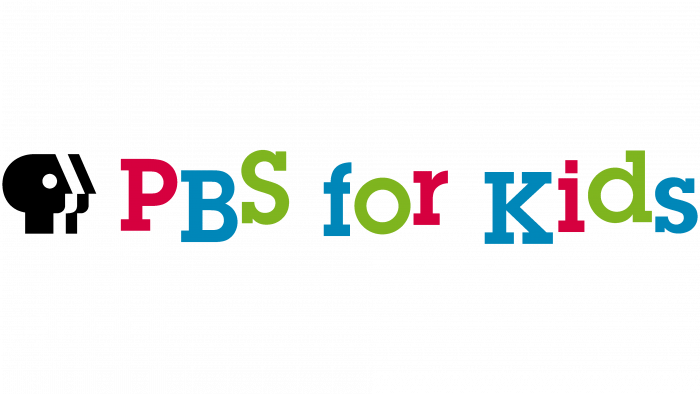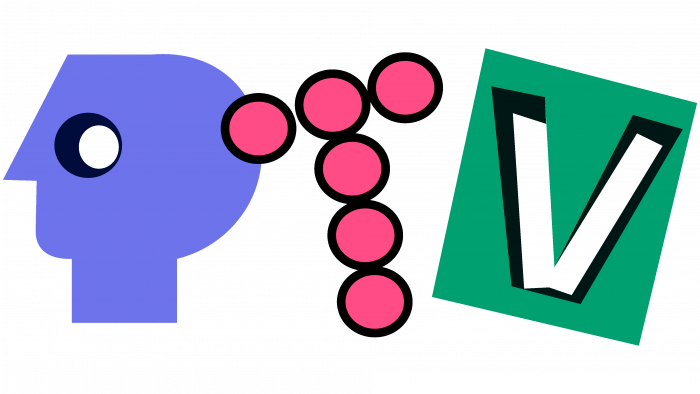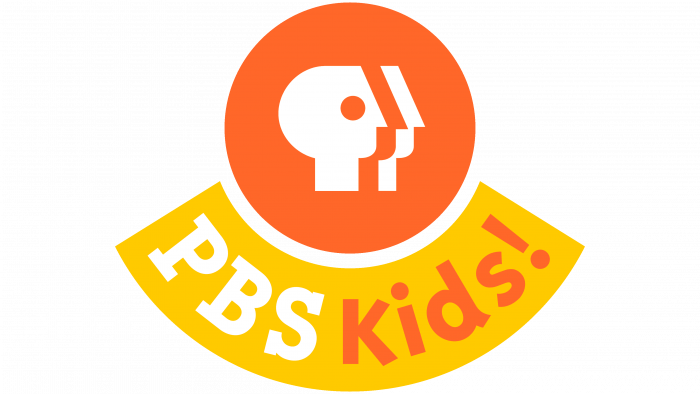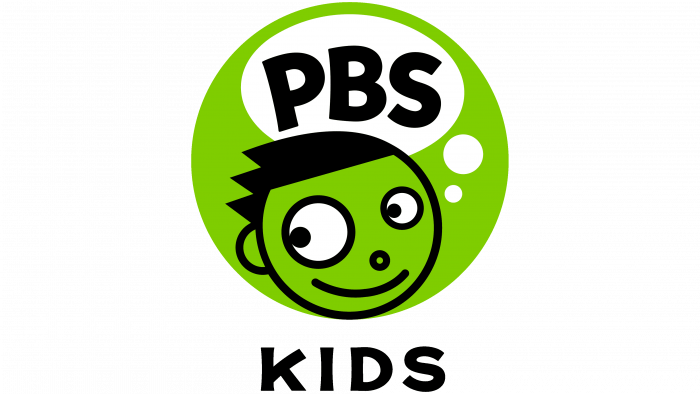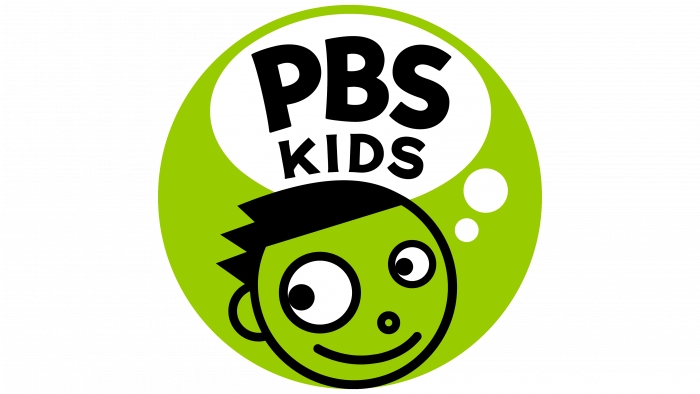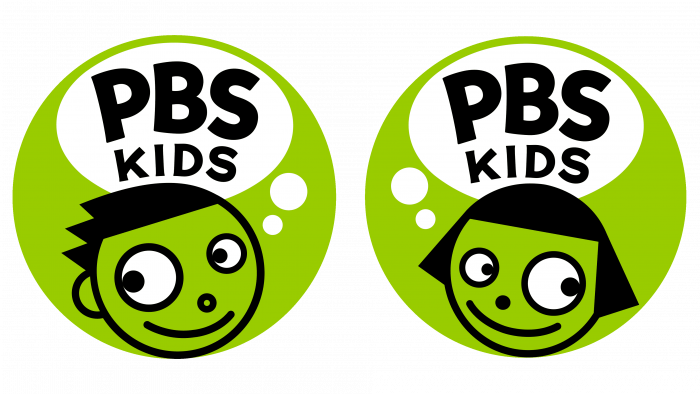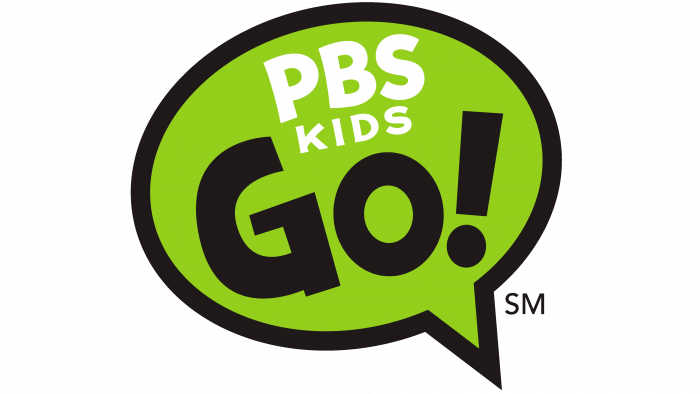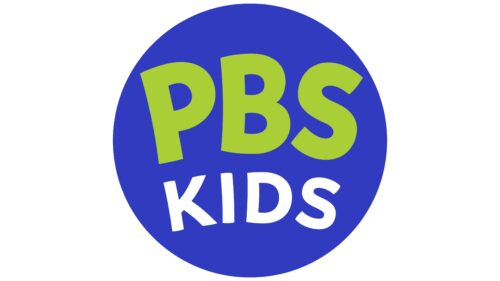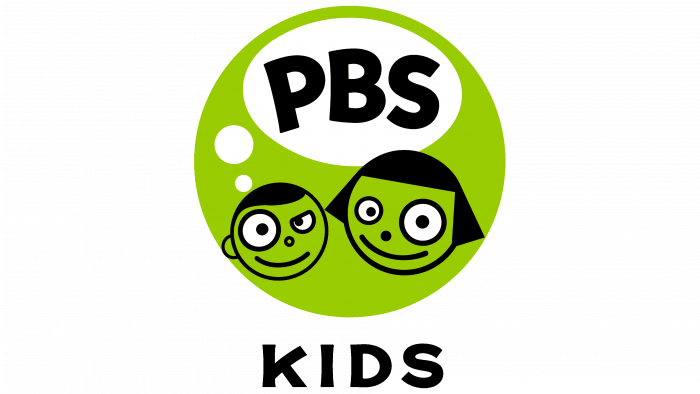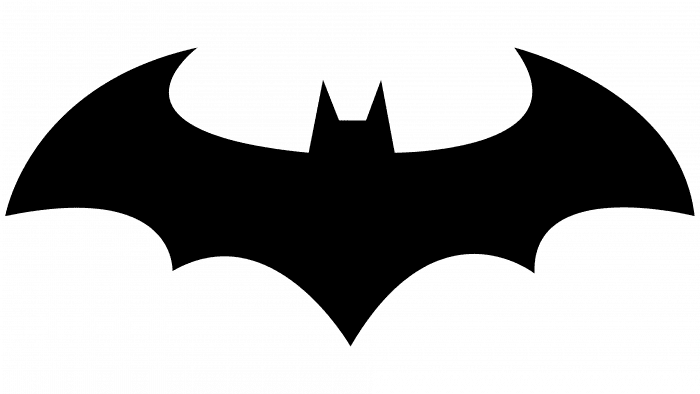The PBS Kids logo showcases a block of programming filled with childhood. This is a specific list of useful and safe content united by a single thread. Curiosity, knowledge, and development lie behind the emblem.
PBS Kids: Brand overview
Meaning and History
PBS Kids was launched in 1993 as an initiative of its own Ready to Learn project, open to facilitate access to educational programs for children from low-income families. In 1994, the authors combined the programs into a PTV block and added a new P-Pals badge. It collected animated characters in PBS network logos, representing educational materials from PTV Park’s fantasy world.
In 1999, the Public Broadcasting Service reopened PBS Kids, including several broadcasts and video programs under a common brand. The programs were intended for children from three to eight years old. The children’s channel worked in this format for six years. Then, in 2000, Bookworm Bunch was added to it—a Saturday block that aired in the morning. In 2004, PBS Kids Go! Programs appeared to be aimed at children of senior school age.
2005, the network closed, giving way to commercial cable and satellite channels. For a long time, the children’s TV service existed separately and was part of a package of various streaming players. Its final relaunch took place in the winter of 2017 across multiple platforms. Every major update brought its logo—five of them in total.
What is PBS Kids?
It is the American brand of children’s television programs broadcast by the Public Broadcasting Service and the television channel of the same name. The program first appeared in 1994, and in 2017 it became a round-the-clock channel. Her website was later launched.
1993 – 1999
The debut logo of PBS Kids was animated and appeared simultaneously with the channel’s opening. It was developed by studio WGBH-TV, which included designers Chris Pullman and Gene Mackles. The logo was based on the 1984 test channel Ready To Learn, which operated in eleven test markets. It consisted of three stylized heads in different colors decorated with patterns.
The image represented anthropomorphic creatures with arms and legs. They were called P-Pals and were set against a neutral white background. Their colors constantly changed in the animated version, stopping in blue, orange, and green. The little people danced and sang, “This is P-B-S!” And then froze when a red barking dog appeared at the screen’s bottom edge. At this time, the extreme head said, “Woo-hoo-hoo!” And the baseball cap flew off it. In the lower corner was the name of the PBS channel. It was painted black. Since 1997, a balloon with the designation E/I appeared on the logo. In this form, the emblem existed until 1999.
In parallel, a printed version was used, static, without animation. It was also based on three heads – only in a monochrome palette. The first head was black, the second was white, and the last was black. Only the first was visible, while the rest were depicted in negative space and acted as the background for the extreme. On the right side, a large “PBS for Kids” sign was painted in different colors (red, green, and blue). The letters were “bouncing,” so they went beyond the straight line. Designers supplemented them with wide rectangular serifs.
1994 – 1999
In the summer of 1994, the children’s channel was renamed PTV. But this measure was not a radical rebranding since the logo with the P-Pals heads was used until 1999 inclusive. The P-Head version was based on another PBS emblem from 1971. The new logo featured a blue head looking to the left (in previous versions, the head pointed to the right). Next to it was the letter “T,” made up of miniature red balls and a black and white “V” in a vertical green rectangle.
1998 – 1999
PBS Kids emerged as a concept in early 1997 and was associated with a renaming process as part of continuous research and experimentation. This emblem has been used in promotional videos, splash screens, and animated FableVision. It had a large red circle with three heads, like the 1993 PBS for Kids logo. Below was a wide yellow half-arc directed upwards. It contained the actual name of the channel, followed by an exclamation mark at the end. The acronym “PBS” was white; the word “Kids” was red. The font used is Lubalin Graph Demi. Big Blue Dot designed her.
1999 – 2013
On the day of the premiere of Dragon Tales, the P-Pals (three multi-colored heads) image was completely abandoned, and the new name of the TV channel was approved – PBS Kids. At the same time, mascots appeared on it – Dash and Dot. The logos were designed by Lee Hunt Associates, which included Richard McGuire, designer for The New Yorker, and Bob Shea. At first, the identity animation was carried out by King Camera and Passion Pictures, but in 2000, the updated versions of the television logo were released by the Primal Screen company.
The round logo featured two smiling faces, one a boy and the other a girl. They had different hairstyles, but otherwise, everything looked the same: round eyes (one large, the other small), a dotted nose, and a half-arc extended upward, indicating a closed mouth. From the heads came small white circles, forming a speech cloud where “PBS” was written in black grotesque. Beneath the green balloons was the word “Kids” in a sleek, capsized typeface.
2008 – 2022
In 2008, the emblem underwent a minor change. The designers enlarged the balloon and the dialog bubble to accommodate the “Kids” caption. As a result, the name of the children’s network became integral. The developers also tweaked the color, making it light olive. 2013, the company dropped the Dot badge, leaving only the Dash variant. But in programs, the deleted version is still used along with the new characters Dee and Del. The main creators of the PBS Kids’ on-air image were Primal Screen Studios, Interface Media Group, and Karptoons.
The children’s channel’s identity underwent a long and serious redesign, after which it received the most harmonious logo. Development moved from multi-structured forms to simple and singular. Therefore, instead of three faces in the profile, one is used and placed in full face. It is cheerful and smiling, which corresponds to the mood of the children’s audience.
Two typefaces were used in the logo at different times: Lubalin Graph Demi and PBS KIDS Headline. In the early versions, the signature palette consisted of red, blue, and green; in the later ones, it was yellow, white, black, and green olive.
2022 – today
The new PBS Kids logo caused a mixed reaction among viewers: while some see it as the embodiment of fresh ideas, others consider it another “victim” of minimalism. It was presented on the last day of June 2022 and debuted on television on July 19. A green boy named Dash has disappeared for the first time in 23 years. Now, the emblem contains only the name of the TV channel, divided into two arched lines. The letters “PBS” are large and green. The word “KIDS” is almost half the size of the abbreviation and is painted white. The base, as before, is round, but now it is bright blue.
This results from collaborating with PBS Kids’ designers and the American company Lippincott. Even though the logo was presented just now, work has been ongoing since 2019. First, the experts found out whether it was possible to eliminate the Dash mascot and how the audience would react to such a change. After interviewing 33 US families, the staff found that children do not perceive the face of the boy in the emblem as something mandatory and are not at all attached to the child’s character. It turned out that the target audience recognizes the sign of the TV channel by its typography, which applies even to those who cannot read yet.
So, the designers began to develop an unexpected direction – the logo of the children’s channel with a “non-childish” design. Of course, there is nothing adult in him, but there is also no funny boy. From a functional point of view, this allowed us to make the emblem universal because now it must adapt not only to widescreen TVs but also to small screens of mobile devices. Therefore, the inscription became larger and more legible.
PBS Kids: Interesting Facts
PBS Kids is part of the Public Broadcasting Service (PBS) in the United States and offers TV shows for kids. It’s known for reliable educational and fun content that both kids and adults appreciate.
- Starting Point: It began on July 11, 1994, aiming to educate kids nationwide. It grew from earlier children’s shows on PBS into its special brand for kids.
- Learning First: PBS Kids teaches kids important stuff like reading, math, science, and how to get along with others through fun and interactive shows.
- Awards Galore: Shows like “Sesame Street,” “Arthur,” “Mister Rogers’ Neighborhood,” and “Reading Rainbow” have won lots of awards for how good they are and how much they help with learning.
- For Everyone: PBS Kids offers stories and characters from different cultures and backgrounds for kids of all ages and interests.
- Tech Smart: PBS Kids uses technology, such as websites, games, and apps, to accompany its TV shows and make learning even more fun.
- PBS Kids GO!: Launched in 2004 for kids aged 6–8, it offered shows, games, and activities for school-age kids. Although it’s no longer its brand, its programs and ideas are still part of PBS Kids.
- Help for Grown-Ups: PBS Kids also helps parents and teachers with resources to make learning fun and effective through websites offering tips and educational materials.
- Always On In January 2017, PBS Kids started a 24/7 channel and live stream, so kids can watch anytime, keeping up with how families watch TV today.
- Green Lessons: Shows like “Wild Kratts” and “Nature Cat” teach kids about nature, animals, and how to care for the environment.
- Beyond TV: PBS Kids works with communities, local PBS stations, schools, and libraries to organize events and activities that help kids learn and get involved in their communities.
PBS Kids is a favorite for kids, parents, and teachers because it makes learning fun and covers important skills and lessons. It’s praised for its focus on education, variety, and the use of new learning methods.
Font and Colors
When Lippincott found that viewers would recognize PBS Kids from typography, they decided to work on that aspect. As a result, the name of the TV channel became the main and only element of the logo, apart from the round base. To improve its readability, the designers enlarged the letters. In doing so, they retained the original bold font known as the PBS KIDS Headline. Art studio Chank Company created it specifically for the children’s TV channel.
The rebranding also touched on the color scheme. The green circle has turned blue for greater contrast; the inscription stands out well against such a background. The first word, “PBS,” on the other hand, is recolored in lime green. The developers of the emblem made the second line white to balance the bright colors.
FAQ
Why did PBS KIDS change their logo?
The brand updated its logo to remain fresh and relevant as digital media evolves. They introduced a new logo to keep up with current trends and appeal to young viewers and their parents.
The update aims to ensure the brand looks consistent across all media platforms. Because kids use different devices, a consistent look helps people recognize and feel brand loyalty. The new logo is more fun and attractive, with bright colors and a simple design that will catch the attention of both children and adults.
What does PBS KIDS stand for?
This is the children’s programming section of the Public Broadcasting Service (PBS) in the United States, intended for children aged 2 to 8 years. The project aims to provide educational content through TV shows, online platforms, and multimedia applications to support early learning.
The brand’s content helps children develop important life skills such as literacy, math, and social-emotional skills in a fun and engaging way. It is known for its quality content, which parents trust, with stories, colorful animation, and interactive elements that attract young viewers. The brand offers digital content, including streaming videos, games, and activities on its website and app, making learning accessible to children anytime.
Who designed the PBS KIDS logo?
Chris Pullman and Gene Maccles designed the original logo. Richard McGuire, known for his work at The New Yorker, and Bob Shea did the latest update. Chank Co. created the fonts for this logo. This team effort combined unique styles and skills to create a logo that looks good and fits well with the brand’s focus on educating young viewers. The new design retains the fun and lively feel of the original while adding a modern twist that reflects the brand’s goals.
What happened to the PBS Kids logo?
The logo changed significantly in 2014 when the character Dash was removed from the main logo. After Dash was removed, Dee and Del, introduced as Dash’s younger siblings, began appearing in some of the brand’s shows. Although Dash was no longer in the main logo, the character appeared in separate animated segments. This update was an attempt to keep the brand attractive and relevant to younger viewers.
What is the PBS Kids slogan?
The slogan “PBS KIDS. Be More Inspired” shows the brand’s desire to motivate young viewers with educational content. The phrase “A small miracle goes a long way” emphasizes the power of curiosity and learning. Both slogans are intended to show how educational television can promote children’s creativity and knowledge, making learning memorable and enjoyable.
How do you make the PBS Kids logo?
To create a PBS Kids logo, use basic art supplies such as pencils and paints or choose digital graphic design software. Start by reviewing existing logo versions to get the right design and colors. If you need help, there are plenty of tutorials online, including YouTube videos. These tutorials provide clear step-by-step instructions on freehand drawing and digital creation techniques. This way, anyone can create a logo regardless of their artistic skills and preferred medium.
